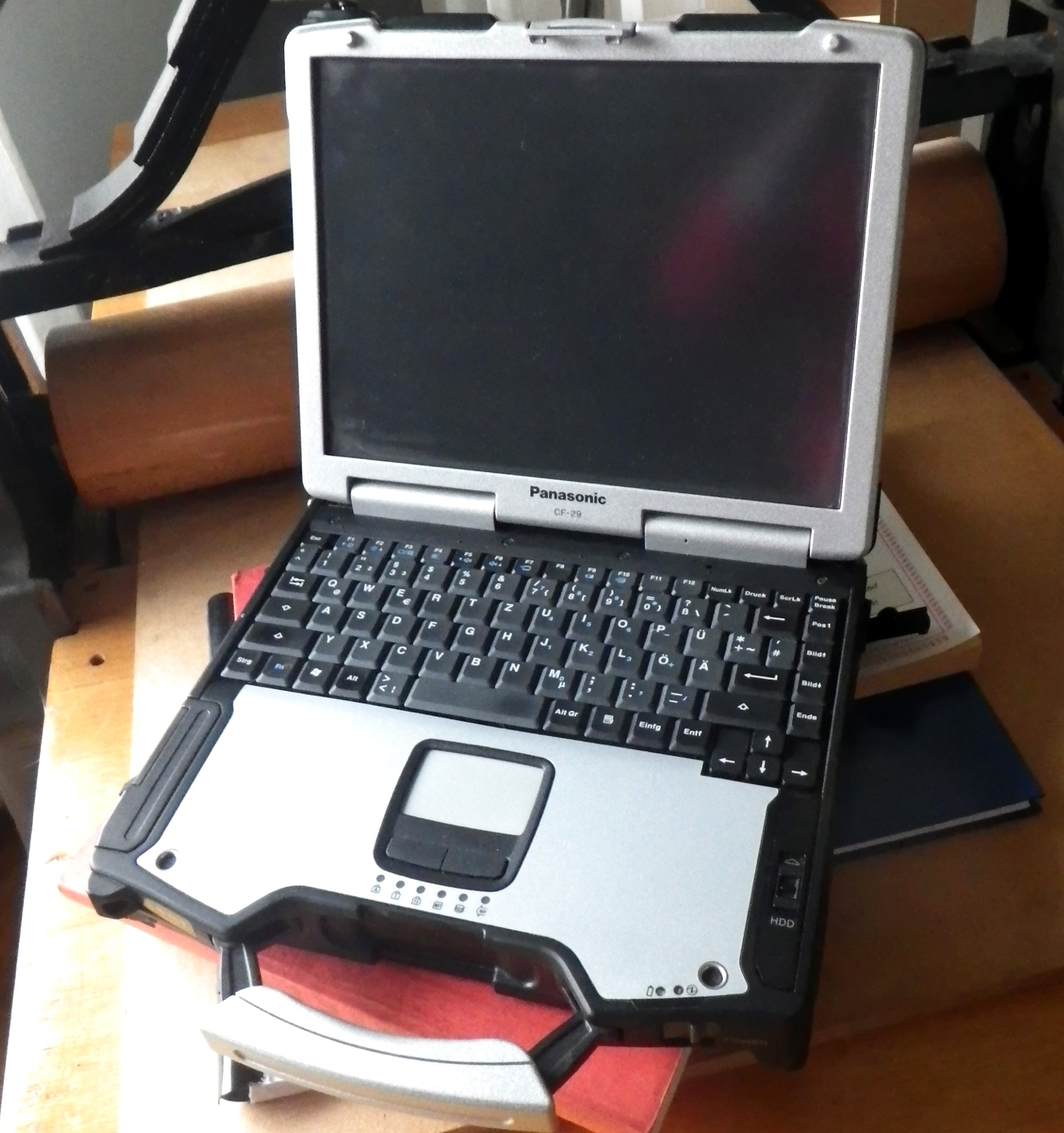|
Tadpole Computer
Tadpole Computer was a manufacturer of rugged, military specification, UNIX workstations, thin client laptops and lightweight servers. History Tadpole was founded in 1994 and originally based in Cambridge, England, then for a time in Cupertino, California. In 1998, Tadpole acquired RDI Computer Corporation of Carlsbad, California, who produced the competing Britelite and Powerlite portable SPARC-based systems, for $6 million. Tadpole was later acquired by defense contractor General Dynamics, in April 2005. Production continued until March 2013 but since then, they no longer sell any systems; and support for their products is provided by Flextronics. An anonymous US intelligence officer had stated to Reuters in 2013 that a decade earlier the US secretly created a company reselling laptops from Tadpole Computer to Asian governments. The reseller added secret software that allowed intelligence analysts to access the machines remotely. Products Tadpole laptops used a variety o ... [...More Info...] [...Related Items...] OR: [Wikipedia] [Google] [Baidu] |
General Dynamics
General Dynamics Corporation (GD) is an American publicly traded, aerospace and defense corporation headquartered in Reston, Virginia. As of 2020, it was the fifth-largest defense contractor in the world by arms sales, and 5th largest in the United States by total sales. The company is a Fortune 100 company, and was ranked No. 94 in 2022. Formed in 1954 with the merger of submarine manufacturer Electric Boat and aircraft manufacturer Canadair, the corporation today consists of ten subsidiary companies with operations in 45 countries. The company's products include Gulfstream business jets, Virginia- and Columbia-class nuclear-powered submarines, Arleigh Burke-class guided-missile destroyers, M1 Abrams tanks and Stryker armored fighting vehicles. In 2021, General Dynamics had worldwide sales of $38.85 billion and a workforce of approximately 103,000 full-time employees. The current chairman and chief executive officer (CEO) is Phebe Novakovic. History Electric Boat Ge ... [...More Info...] [...Related Items...] OR: [Wikipedia] [Google] [Baidu] |
Tadpole SPARCBook (1)
A tadpole is the larval stage in the biological life cycle of an amphibian. Most tadpoles are fully aquatic, though some species of amphibians have tadpoles that are terrestrial. Tadpoles have some fish-like features that may not be found in adult amphibians such as a lateral line, gills and swimming tails. As they undergo metamorphosis, they start to develop functional lungs for breathing air, and the diet of tadpoles changes drastically. A few amphibians, such as some members of the frog family Brevicipitidae, undergo direct development i.e., they do not undergo a free-living larval stage as tadpoles instead emerging from eggs as fully formed "froglet" miniatures of the adult morphology. Some other species hatch into tadpoles underneath the skin of the female adult or are kept in a pouch until after metamorphosis. Having no hard skeletons, it might be expected that tadpole fossils would not exist. However, traces of biofilms have been preserved and fossil tadpoles have been ... [...More Info...] [...Related Items...] OR: [Wikipedia] [Google] [Baidu] |
Toughbook
Toughbook is a line of rugged computers produced and marketed by Panasonic Corporation. The Toughbook, introduced in 1996 with the CF-25, is designed to withstand outside forces which would damage or destroy normal laptops. Toughbook mobile computers are used in a wide variety of industries, including construction, defense, emergency services, government, healthcare, law enforcement, manufacturing, oil, gas, telecom, and utilities. The Toughbook brand mainly competes with other lines of rugged computers, such as Dell's Rugged Extreme. In 2011, Panasonic introduced the Panasonic Toughpad, Toughpad brand of ruggedized tablets, built to many of the same specifications as its Toughbook laptop line. Testing According to Panasonic, over 501 tests and quality checks are performed during production and all units are subjected to a factory burn-in period. Several independent tests have been conducted to determine the resistance of Toughbook computers to external forces. Fully rugged ... [...More Info...] [...Related Items...] OR: [Wikipedia] [Google] [Baidu] |
Military Computers
This article specifically addresses U.S. armed forces military computers and their use. History Some of the earliest computers were military computers. Military requirements for portability and ruggedness led to some of the earliest transistorized computers, such as the 1958 AN/USQ-17, the 1959 AN/MYK-1 ( MOBIDIC), the 1960 M18 FADAC, and the 1962 D-17B; the earliest integrated-circuit based computer, the 1964 D-37C; as well as one of the earliest laptop computers, the 1982 Grid Compass. Military requirements for a computer small enough to fit through a submarine's hatch led to the AN/UYK-1. Construction Typically a military computer is much more robust than an industrial computer enclosure. Most electronics will be protected with a layer of conformal coating. There will be more structure inside to support the components, the plug-in cards will be individually supported and secured to assure they do not pop out of their sockets, the processor and heat sink will be secured, m ... [...More Info...] [...Related Items...] OR: [Wikipedia] [Google] [Baidu] |
Microsoft Windows
Windows is a group of several proprietary graphical operating system families developed and marketed by Microsoft. Each family caters to a certain sector of the computing industry. For example, Windows NT for consumers, Windows Server for servers, and Windows IoT for embedded systems. Defunct Windows families include Windows 9x, Windows Mobile, and Windows Phone. The first version of Windows was released on November 20, 1985, as a graphical operating system shell for MS-DOS in response to the growing interest in graphical user interfaces (GUIs). Windows is the most popular desktop operating system in the world, with 75% market share , according to StatCounter. However, Windows is not the most used operating system when including both mobile and desktop OSes, due to Android's massive growth. , the most recent version of Windows is Windows 11 for consumer PCs and tablets, Windows 11 Enterprise for corporations, and Windows Server 2022 for servers. Genealogy By marketing ... [...More Info...] [...Related Items...] OR: [Wikipedia] [Google] [Baidu] |
IBM AIX
AIX (Advanced Interactive eXecutive, pronounced , "ay-eye-ex") is a series of Proprietary software, proprietary Unix operating systems developed and sold by IBM for several of its computer platforms. Background Originally released for the IBM RT PC RISC workstation in 1986, AIX has supported a wide variety of hardware platforms, including the IBM RS/6000 series and later IBM Power microprocessors, Power and PowerPC-based systems, IBM System i, System/370 mainframes, IBM Personal System/2, PS/2 personal computers, and the Apple Network Server. It is currently supported on IBM Power Systems alongside IBM i and Linux. AIX is based on UNIX System V with 4.3BSD-compatible extensions. It is certified to the UNIX 03 and UNIX V7 marks of the Single UNIX Specification, beginning with AIX versions 5.3 and 7.2 TL5 respectively. Older versions were previously certified to the UNIX 95 and UNIX 98 marks. AIX was the first operating system to have a journaling file system, and IBM has c ... [...More Info...] [...Related Items...] OR: [Wikipedia] [Google] [Baidu] |
PowerPC 600
The PowerPC 600 family was the first family of PowerPC processors built. They were designed at the Somerset facility in Austin, Texas, jointly funded and staffed by engineers from IBM and Motorola as a part of the AIM alliance. Somerset was opened in 1992 and its goal was to make the first PowerPC processor and then keep designing general purpose PowerPC processors for personal computers. The first incarnation became the PowerPC 601 in 1993, and the second generation soon followed with the PowerPC 603, PowerPC 604 and the 64-bit PowerPC 620. Nuclear family PowerPC 601 The PowerPC 601 was the first generation of microprocessors to support the basic 32-bit PowerPC instruction set. The design effort started in earnest in mid-1991 and the first prototype chips were available in October 1992. The first 601 processors were introduced in an IBM RS/6000 workstation in October 1993 (alongside its more powerful multichip cousin IBM POWER2 line of processors) and the first Apple Power M ... [...More Info...] [...Related Items...] OR: [Wikipedia] [Google] [Baidu] |
OpenVMS
OpenVMS, often referred to as just VMS, is a multi-user, multiprocessing and virtual memory-based operating system. It is designed to support time-sharing, batch processing, transaction processing and workstation applications. Customers using OpenVMS include banks and financial services, hospitals and healthcare, telecommunications operators, network information services, and industrial manufacturers. During the 1990s and 2000s, there were approximately half a million VMS systems in operation worldwide. It was first announced by Digital Equipment Corporation (DEC) as VAX/VMS (''Virtual Address eXtension/Virtual Memory System'') alongside the VAX-11/780 minicomputer in 1977. OpenVMS has subsequently been ported to run on DEC Alpha systems, the Itanium-based HPE Integrity Servers, and select x86-64 hardware and hypervisors. Since 2014, OpenVMS is developed and supported by VMS Software Inc. (VSI). OpenVMS offers high availability through clustering — the ability to distribute the ... [...More Info...] [...Related Items...] OR: [Wikipedia] [Google] [Baidu] |
Alpha 21064
The Alpha 21064 is a microprocessor developed and fabricated by Digital Equipment Corporation that implemented the Alpha (introduced as the Alpha AXP) instruction set architecture (ISA). It was introduced as the DECchip 21064 before it was renamed in 1994. The 21064 is also known by its code name, EV4. It was announced in February 1992 with volume availability in September 1992. The 21064 was the first commercial implementation of the Alpha ISA, and the first microprocessor from Digital to be available commercially. It was succeeded by a derivative, the Alpha 21064A in October 1993. This last version was replaced by the Alpha 21164 in 1995. History The first Alpha processor was a test chip codenamed EV3. This test chip was fabricated using Digital's 1.0-micrometre (μm) CMOS-3 process. The test chip lacked a floating point unit and only had 1 KB caches. The test chip was used to confirm the operation of the aggressive circuit design techniques. The test chip, along with sim ... [...More Info...] [...Related Items...] OR: [Wikipedia] [Google] [Baidu] |
Tadpole ALPHAbook 1
A tadpole is the larval stage in the biological life cycle of an amphibian. Most tadpoles are fully aquatic, though some species of amphibians have tadpoles that are terrestrial. Tadpoles have some fish-like features that may not be found in adult amphibians such as a lateral line, gills and swimming tails. As they undergo metamorphosis, they start to develop functional lungs for breathing air, and the diet of tadpoles changes drastically. A few amphibians, such as some members of the frog family Brevicipitidae, undergo direct development i.e., they do not undergo a free-living larval stage as tadpoles instead emerging from eggs as fully formed "froglet" miniatures of the adult morphology. Some other species hatch into tadpoles underneath the skin of the female adult or are kept in a pouch until after metamorphosis. Having no hard skeletons, it might be expected that tadpole fossils would not exist. However, traces of biofilms have been preserved and fossil tadpoles have been ... [...More Info...] [...Related Items...] OR: [Wikipedia] [Google] [Baidu] |
UltraSPARC III
The UltraSPARC III, code-named "Cheetah", is a microprocessor that implements the SPARC, SPARC V9 instruction set architecture (ISA) developed by Sun Microsystems and fabricated by Texas Instruments. It was introduced in 2001 and operates at 600 to 900 MHz. It was succeeded by the UltraSPARC IV in 2004. Gary Lauterbach was the chief architect. History When presented at the '97 Microprocessor Forum, the probable introduction date for the UltraSPARC III was 1999, and it would have competed with Digital Equipment Corporation's Alpha 21264 and Intel's Itanium (Merced). This was not to be the case as it was delayed until 2001. Despite being late, it was awarded the Analysts' Choice Award for Best Server/Workstation Processor of 2001 by ''Microprocessor Report'' for its multiprocessing features. Description The UltraSPARC III is an Out-of-order execution, in-order superscalar microprocessor. The UltraSPARC III was designed for Shared memory (interprocess communication), sha ... [...More Info...] [...Related Items...] OR: [Wikipedia] [Google] [Baidu] |
.jpg)






.jpg)